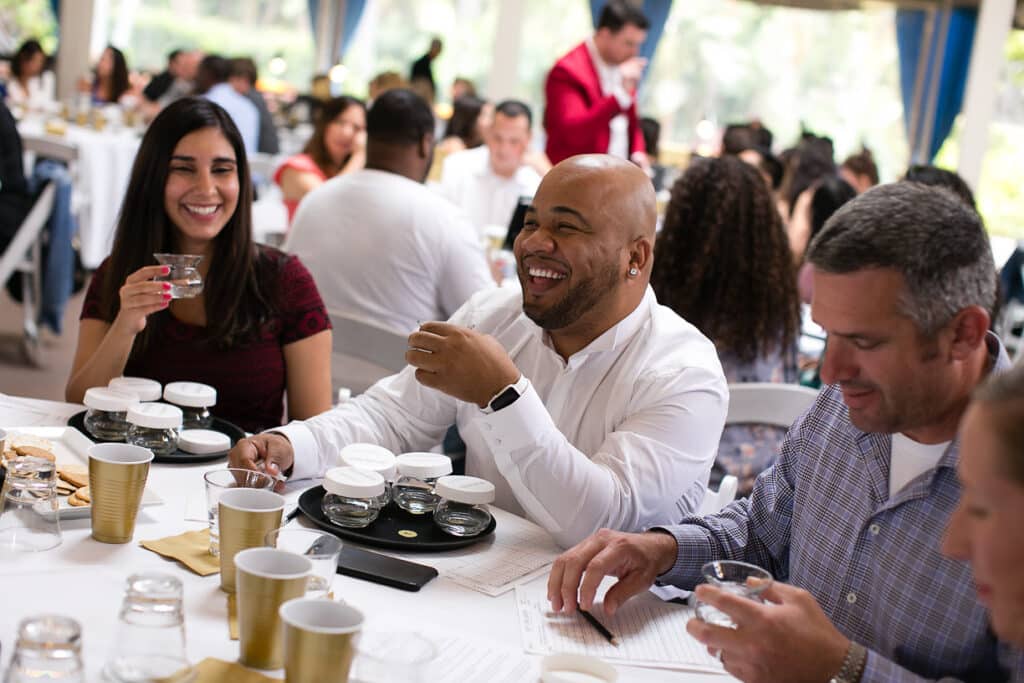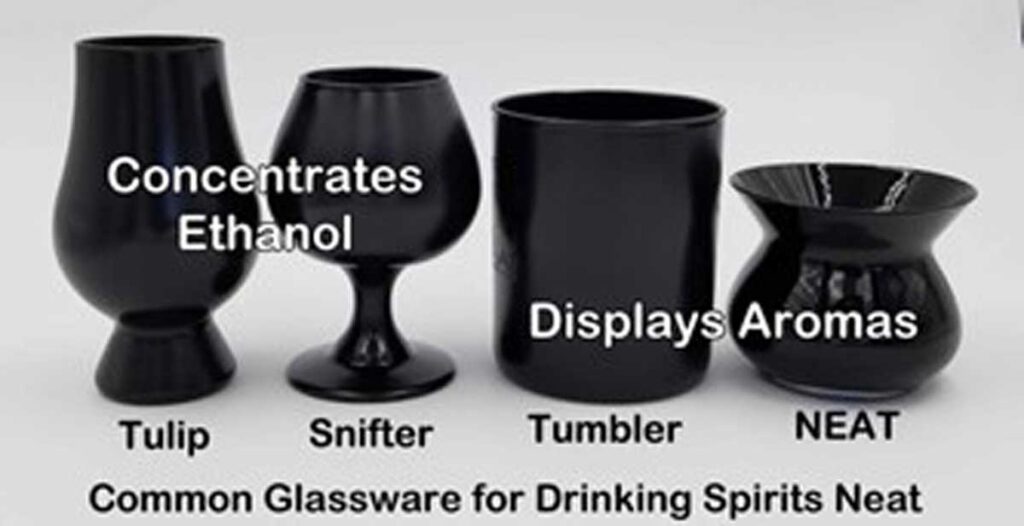
Elevating Whiskey Evaluations to Achieve a New, Higher Perspective
George F Manska, CR&D Arsilica, Inc.
Most people in the alcohol beverage industry take a personal interest in the sensory attributes of beverages. Bartenders, mixologists, servers, distributors, and brand ambassadors enjoy attending tastings at expos, restaurants, and wine and liquor stores to experience and discuss tastes, aromas, and flavors of beverages, and many belong to wine or whiskey clubs. This process breeds a few well-informed “frequent flier regulars” who really know their stuff, emerging at various events to contribute to the educational process at the attendee/guest level. Still, the information presented by the admins of these events differs widely by beverage for an unsuspected reason.
Wine and beer tastings are characterized by a number of “regulars” who demonstrate an exceptional ability to nail flavors, aromas, and other descriptors, and their confidence level and knowledge are generally high, with vocal participation, and contribution to flavor profiles, drinkability, and pairings. More often than not, leaders/admins in these events refrain from imposing flavor descriptors on the attendees before tasting and expounding on beverage characteristics after tasting. Many comment on balance, acidity, and mouthfeel, and are not afraid to say, “This wine (or beer) is too hot (referring to ethanol content).” As the seasoned tasters share knowledge, newbies learn to associate specific flavors with grain, hops, and grape varietals. Spirits events, particularly whiskey, are another story.
Whiskey tastings are much different, having less vocal audience participation. No one ever at a whiskey tasting said, “This whiskey is too hot.” There are no comments on balance acidity and very few regarding profiles, drinkability, pairings, etc. Seasoned tasters sniff the ethanol, nod their heads approvingly, and look around the room to see if others follow suit. Complete personal satisfaction seems to occur at the olfactory discovery of pungent ethanol as a final assurance they received what they came for. Any discussion of the flavor profile is introduced before tasting by a leader or brand ambassador who relates carefully chosen, corporate-prepared descriptors as pre-tasting semi-subliminal suggestions to prime attendees for the sales pitch, knowing full well that sniffers do not work well once filled with abundant ethanol fumes. Attendee comments are generally “This is good,” or “I like it,” or the highly descriptive “Wow.”
Spirits lovers reading this will immediately say, “Of course, stupid, they are different beverages, they provide different information,” but that is not the whole story. The result of group tastings should be the experience of flavors and aromas and a forum for sensory information and discussion regardless of beverage. Whiskey (spirits) drinkers should be able to discern spirit flavor profiles. Given the price of spirits, accurate detection of flavors and aromas should be a primary purchasing decision. Sadly, it is not.
Why? At first glance, the levels of anesthetic ethanol in each type of beverage seem to be the major difference, but that is a superficial observation. The real culprit is the glassware. Let’s discuss the long-accepted glassware used for each type of beverage to see how ethanol and flavors are manipulated to display aroma profiles.
Beer glasses: Certain shapes have become identified with specific beers since the medieval era. Beer glass styles were associated with popular beers, which was clever marketing for the time. A few basic styles have survived: the pilsner for lighter beers, the tulip for medium-body beers, and the chalice for stouts, high ethanol, heavy, and highly aromatic beers. Over the centuries, they have gotten it right for most beers, ranging from 3 to 12% ethanol. However, the public prefers the standard English pub pint glass filled to the rim to ensure a “pour to the rim with no headspace to appreciate aromas. At least, after the first two sips, there is enough headspace to collect aromas to sniff and savor and relatively low levels of anesthetic, ethanol, permit, flavor, and appreciation prior to anesthetization. Serious craft beer drinkers are all about their beer’s flavor, aroma, and taste. Although the glasses could improve, sensory considerations exist, at least to an acceptable degree.
Wine glasses: Over the years, these have been narrowed down to three basic shapes:
- Large, wide bowl wine glasses are generally best for reds to appreciate the complexity of a wide variety of flavors and aromas,
- Tulips concentrate narrow aroma profiles of white wines and
- Flutes prevent the quick escape of the bubbles in sparkling wines.
Most wines range from 6% to 17% ethanol. Wine glasses have a distinct headspace to insert the nose and appreciate flavors and aromas, except flutes. Headspace size is generally managed by the pour, which is usually much less than half the volume of the empty glass, allowing adequate headspace for nosing aromas. Too much olfactory ethanol is disagreeable to most wine drinkers, and they know it interferes with their search for flavor. Serious wine drinkers are all about the taste and aroma of wine, and although the glasses could stand some improvement, sensory considerations exist to a high degree. Consequently, tasting discussions are sensory-oriented, and those ”This stuff is good” comments do not mark the end of the sensory experience and instead, promote deeper discussion, “Why do you think so?”

Whiskey glasses: Until recently, spirits drinkers have widely accepted two basic shapes: the iconic tulip and the tumbler. Far more accepted is the tulip, an evolutionary descendant of the tiny copita sherry glass. Characterized by tiny rims too small to insert the nose and small bowl diameters to prevent swirling, tulips give no choice or possibility of separating pungent, anesthetic, nose-numbing ethanol from the aroma profile, and in fact, tulips concentrate headspace ethanol aromas to 65 to 75%, with 2 to 3% character aromas, the rest being air and 2 to 4% water, due to the high volatility of ethanol.
Originally designed for 22% ethanol fortified wines, when tulips are used for spirits, they become an ethanol nose bomb, frequently referred to by serious whiskey drinkers as “nose-cannons.” Concentrated ethanol limits accurate sensory diagnostics to lingering but quickly fading two-sniff memories. Even the experts’ opinions are affected by the olfactory ethanol barrier to flavor perception.
The Tulip Problem: Whiskey glassware is a sensory problem. Tulips, the most popular, iconic spirits ethanol delivery devices, are the primary reason whiskey event commentaries end with “This stuff is good.” The follow-up “I’ll buy it” is often an obligatory response to the free tasting samples and presentation and is usually not about personal preference. Tulips are a driving force behind the whiskey drinkers’ quest for higher ethanol. Distillers, recognizing a windfall opportunity, created a new “cask strength” market segment for straight, neat whiskey drinkers, reasoning that undiluted spirits directly from the cask are the “purest” and “highest” form of whiskey possible. Assessing flavor and appreciating the drinking experience of cask strengths from a tulip is exponentially more complex than 40% ABV (alcohol by volume) spirits. Why don’t more drinkers know this? Because they are completely unaware of the silent, painless onset of ethanol nose-blindness.
As long as tiny-rim tulips are the standard, most whiskey drinkers/tasters will remain in an ethanol fog and resort to buying popular labels, rare selections, celebrity endorsements, and cleverly advertised spirits regardless of personal sensory experience, fooling themselves into submitting to pre-tasting subliminal flavor suggestions of corporate brand ambassadors and marketers. Spirits drinkers will follow the passing show of revered gurus, mavens, and celebrities who drink from tulips and dictate what drinkers should buy, perhaps augmented by competition medal awards, without considering true attributes or flaws. Instead, they relate their own personal preferences. Many companies are beginning to realize that the best spirits glass design is more complicated than non-functional tradition or a pleasing style.

State of the Art: Whiskey evaluation and appreciation in its current state has become a status participation game designed to replace your personal opinion with high-powered marketing and buying suggestions. It exists solely because whiskey drinkers encourage and unconsciously demand it by prioritizing pungent olfactory ethanol over discovery, enjoyment, and discussion; add to that a general propensity to let someone else make your decisions because thinking objectively “hurts your brain.” Gurus, mavens, and competitions help guide drinkers only because drinkers insist on confusing the pungency of ethanol with characteristic aroma and flavor, and many equate high ABV with quality.
Ethanol pungency is exactly the same for all spirits of 40% ABV (escalated for higher ABV) and has absolutely no relationship to character or flavor. Unfortunately, most whiskey drinkers confuse “cask strength” with quality. Since cask-strength spirits cost more, an irrational leap to “more ethanol means better quality” is almost natural.
Summary: It’s time for us to rise above the marketing madness and bring fun, opinion, sensory perception, and knowledge into the whiskey-tasting game by becoming serious whiskey drinkers. It can begin by choosing glassware designed to deliver flavor and sensory enjoyment without the upfront anesthetic ethanol, which quickly numbs the nose to aromas and flavors.
Bio: George F Manska, CR&D, Arsilica, Inc.
Qualifications: Published sensory science researcher, entrepreneur. BSME, NEAT glass co-inventor
Mission: Replace myth and misinformation with scientific truth through consumer education.
More Information: www.theneatglass.com/shop
Note: Enrolled NEATNEWS subscribers are entitled to 10% discount on all purchases and free
shipping over $55 for as long as you are enrolled. Coupon code: ILUVNEAT
